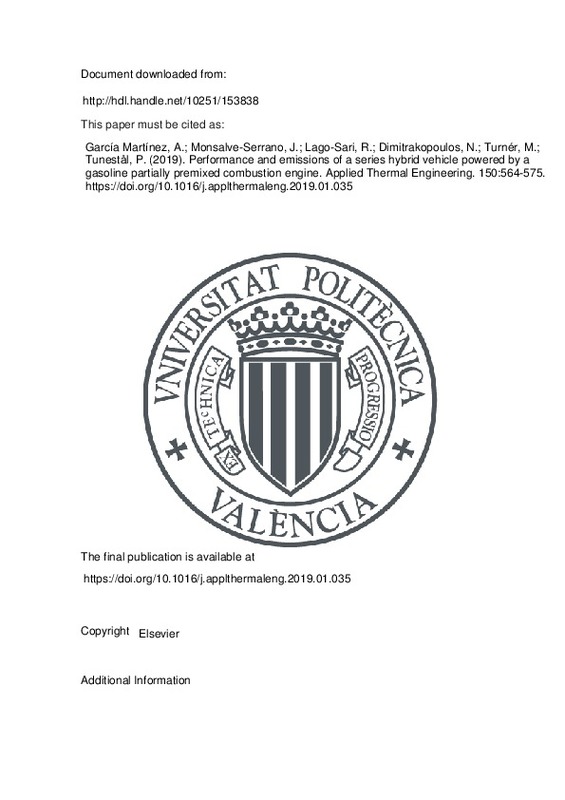JavaScript is disabled for your browser. Some features of this site may not work without it.
Buscar en RiuNet
Listar
Mi cuenta
Estadísticas
Ayuda RiuNet
Admin. UPV
Performance and emissions of a series hybrid vehicle powered by a gasoline partially premixed combustion engine
Mostrar el registro sencillo del ítem
Ficheros en el ítem
| dc.contributor.author | García Martínez, Antonio
|
es_ES |
| dc.contributor.author | Monsalve-Serrano, Javier
|
es_ES |
| dc.contributor.author | Lago-Sari, Rafael
|
es_ES |
| dc.contributor.author | Dimitrakopoulos, Nikolaos
|
es_ES |
| dc.contributor.author | Turnér, Martin
|
es_ES |
| dc.contributor.author | Tunestål, Per
|
es_ES |
| dc.date.accessioned | 2020-11-03T04:31:10Z | |
| dc.date.available | 2020-11-03T04:31:10Z | |
| dc.date.issued | 2019-03-05 | es_ES |
| dc.identifier.issn | 1359-4311 | es_ES |
| dc.identifier.uri | http://hdl.handle.net/10251/153838 | |
| dc.description.abstract | [EN] This work evaluates the performance and emissions of the series hybrid vehicle concept powered by a gasoline partially premixed internal combustion engine. To do so, experimental data was collected from a Volvo VED-D4 Euro 6 four-cylinder compression ignition engine running under gasoline partially premixed combustion. Two series hybrid vehicle models were developed in GT-Power (R), which were fed with the experimental data to evaluate the potential of the hybrid concept. First of all, the battery charging strategy of the hybrid vehicles was optimized in terms of number of power levels and operating conditions. For this, a design of experiments was performed in GT-Power (R), which enabled to obtain a predictive model of the performance and emissions. The predictive model was used to obtain the optimized NOx-fuel consumption Pareto frontiers for each charging strategy proposed. Finally, the GT-Power (R) vehicle models were run with the optimal operating conditions (selected from each Pareto) in both the new European driving cycle and worldwide harmonized light vehicles test cycle. The results show that the hybrid powertrain running with partially premixed combustion is able to achieve similar or better performance than the commercial diesel vehicle with low engine-out emissions. Moreover, comparing the results from both vehicles, it was confirmed that the hybridization results in better improvements when applied to urban traffic than for highway conditions where the power request is higher and the potential for regenerative braking is reduced. | es_ES |
| dc.description.sponsorship | The authors gratefully acknowledge FEDER and Spanish Ministerio de Economia y Competitividad for partially supporting this research through TRANCO project (TRA2017-87694-R). The authors also gratefully acknowledge the KCFP Engine Research Center (Swedish Energy Agency grant number 22485-4) for partial support of this research. | es_ES |
| dc.language | Inglés | es_ES |
| dc.publisher | Elsevier | es_ES |
| dc.relation.ispartof | Applied Thermal Engineering | es_ES |
| dc.rights | Reconocimiento - No comercial - Sin obra derivada (by-nc-nd) | es_ES |
| dc.subject | Low temperature combustion | es_ES |
| dc.subject | Series hybrid vehicle | es_ES |
| dc.subject | Emissions | es_ES |
| dc.subject | Worldwide harmonized light vehicles test cycle | es_ES |
| dc.subject.classification | MAQUINAS Y MOTORES TERMICOS | es_ES |
| dc.title | Performance and emissions of a series hybrid vehicle powered by a gasoline partially premixed combustion engine | es_ES |
| dc.type | Artículo | es_ES |
| dc.identifier.doi | 10.1016/j.applthermaleng.2019.01.035 | es_ES |
| dc.relation.projectID | info:eu-repo/grantAgreement/Swedish Energy Agency//22485-4/ | es_ES |
| dc.relation.projectID | info:eu-repo/grantAgreement/AEI/Plan Estatal de Investigación Científica y Técnica y de Innovación 2013-2016/TRA2017-87694-R/ES/REDUCCION DE CO2 EN EL TRANSPORTE MEDIANTE LA INYECCION DIRECTA DUAL-FUEL DE BIOCOMBUSTIBLES DE SEGUNDA GENERACION/ | es_ES |
| dc.rights.accessRights | Abierto | es_ES |
| dc.contributor.affiliation | Universitat Politècnica de València. Departamento de Máquinas y Motores Térmicos - Departament de Màquines i Motors Tèrmics | es_ES |
| dc.description.bibliographicCitation | García Martínez, A.; Monsalve-Serrano, J.; Lago-Sari, R.; Dimitrakopoulos, N.; Turnér, M.; Tunestål, P. (2019). Performance and emissions of a series hybrid vehicle powered by a gasoline partially premixed combustion engine. Applied Thermal Engineering. 150:564-575. https://doi.org/10.1016/j.applthermaleng.2019.01.035 | es_ES |
| dc.description.accrualMethod | S | es_ES |
| dc.relation.publisherversion | https://doi.org/10.1016/j.applthermaleng.2019.01.035 | es_ES |
| dc.description.upvformatpinicio | 564 | es_ES |
| dc.description.upvformatpfin | 575 | es_ES |
| dc.type.version | info:eu-repo/semantics/publishedVersion | es_ES |
| dc.description.volume | 150 | es_ES |
| dc.relation.pasarela | S\376332 | es_ES |
| dc.contributor.funder | Swedish Energy Agency | es_ES |
| dc.contributor.funder | Agencia Estatal de Investigación | es_ES |
| dc.contributor.funder | European Regional Development Fund | es_ES |







![[Cerrado]](/themes/UPV/images/candado.png)

